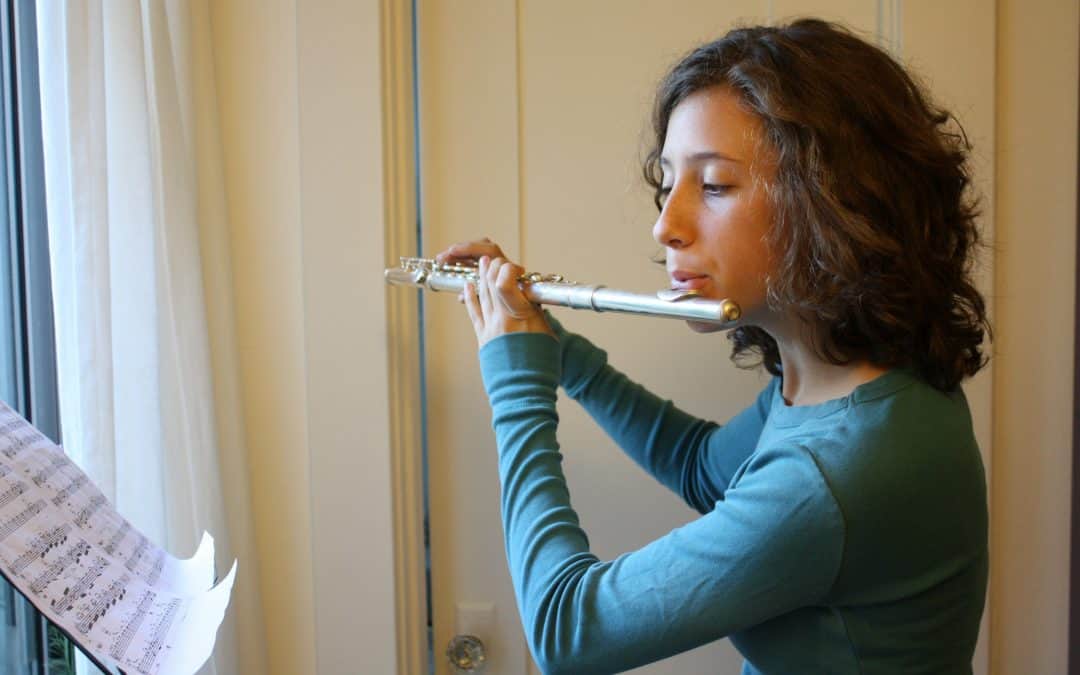Breath-The Essence of Tone by, Dr. September Payne
BREATHING IS LIFE! The air column is the spirit of the tone. Derived from the Latin “spiritus”, it means breath or wind. Marcel Moyse, one of the most iconic flute pedagogues, often said in lessons:
“Give life to the tone!”
Moyse wanted the sound to be alive and vibrant. While vibrato, certain positions of the tongue and specific shapes in the larynx aid tone production, a crucial aspect of tone is breath support.
As wind players, it’s crucial to know how to regulate airflow. Breathing for sitting or speaking is not adequate for flute playing demands, which requires:
- A higher rate of deep breathing energy
- Elongation of the breath cycle
- Deep inhalation whether fast or slow and/or energetic short breath catches
- Faster or sustained controlled, slow exhalation
- Ever sustained air compression (pressure)
Elongation of the Breath Cycle Requires
- More stamina
- Adroit muscle control
- Coordinating supporting of diaphragm and larynx.
Using the Singer’s “Appoggio” Method
- In Appoggio, the diaphragm rises slowly using the muscles of inhalation
- Diaphragm remains in high inspiratory position for as long as possible
- Raised sternum keeps abdominal wall close to the position of inhalation
- Minimal, steady stream (correct select amount for the task) conserves air
- Early ribcage collapse is delayed
- The breathing cycle is extended
What is Support?
- Support gives performers a means of controlling their sound
- Support works by contracting the abdominal muscles
- Creates higher pressure in the abdomen and thorax (supported feeling)
- Allows the diaphragm to relax and rise upward for more control
- The tongue moves into positions that open and close the oral cavity
Appoggio Versus Diaphragmatic Breathing
The term ‘diaphragmatic breathing’ is a bit misleading. Rather, it’s the intercostal/abdominal muscles we develop and control during playing.
- The diaphragm is not consciously engaged for pulling in new breath
- It’s not used to drive air upward for the expulsion of breath
- The diaphragm itself is passive during playing
- We do not exert active control over its movements
- Appoggio is more accurate in describing breathing for playing
Dangers of Tanking Up – Inhaling Too Deeply
- Creates displacement of the chest and collapsing of the rib cage
- Forcing brings tension and noisy breathing
- Breathing is “grabbed” holding the breath in advance of the next phrase
- Creates gasping and rapid and shallow intake of air between phrases
- Can bring hyperventilation lightheadedness and dizziness
Silent Breath Renewals
- Breathe slowly and quietly through the nose and/or mouth
- Good for Legato and slow tempi
- Appears seamless/uninterrupted. Provides less accented re-entrances
- Takes longer to fill lungs to capacity when inhaling through the nose
- Elongates the breath cycle
Using Singer’s Appoggio
At the height of inhalation, when breathing deeply and the lower torso is expanded laterally, dorsally and frontally, the player will feel a sense of ‘suspension’ as though the air or tone is sitting or resting on the rib cage, giving a feeling of buoyancy. This feeling should be maintained for as long as is comfortable, with the sternum still elevated, the epigastric (upper abdomen) area still comfortably full and the lower ribs expanded.
The Appoggio breathing technique gives:
- A longer, more reliable air supply (exiting air is paced to meet the requirements of extended phrases, regardless of tessitura or dynamic level)
- Greater stability of tone (tone is affected greatly by the steadiness of a player’s breath stream)
- Easier execution of large intervals, improved agility, greater tone clarity
- Accuracy and speed while playing technically challenging passages
- Better breath management when playing very quietly.
Appoggio Ensures
- No excessive airflow (exiting breath is turned into tone by vibrating larynx)
- Less resistance (tension) by vocal folds to the exiting air
Breath Support and Stamina
Breath management and tone are interrelated
- Unfocused tone looses air (inadequate closure of vocal folds and mouth aperture)
- Air leaks out instead of facing healthy resistance at the larynx
- Proper support uses up air in a slow, steady stream
In pressed phonation, air is expelled too rapidly from the lungs
- Too much effort pushes apart vocal folds that should be somewhat closed
- Too much air is used up at onset of sound to set vocal chords
- Forced air creates closed, tight, embouchure aperture
- Leaves less air for the remainder of the phrase
Appoggio is a critical way to correct lack stamina or endurance
Forcing
- Never confuse increased breath usage with improved breath support
- Pushing the air out of the lungs to make tone more powerful wastes air
- Pushing out more breath leads to strain
- Allow the air to flow out in appropriate amounts and speed
- Ride the tone on a steady and minimal stream of breath
- Figure out how much air you truly need for a given phrase
Less air in the lungs may give the sensation of running out of breath until learned. Pushing air out as fast disturbs tone quality, pitch and phrase duration.
Remedy
- Breathe less deeply for short phrases
- Eliminate breaths between phrases
- Use correct vocal posturing to obtain optimal resonance.
- Sustain notes at a full volume using resonant tone (not shouting)
- Always have air in reserve
Appoggio Exercise
- Remember, the muscles that support inhalation should be encouraged to return to their initial positions, with the upper abdomen and lower ribs expanded as much as they were at the time of inhalation. This prevents premature rise of the diaphragm and as well strengthens the muscles.
- Entire exercise is to be played on a single breath.
- Use French pronounced vowels mindful of the octave to center the tone:
- Low to Middle Register –Eu Eh
- Middle to Middle High Register–Ooo, Oh, Ah
- High Register–Ee and Ah for flat high notes
- With a centered tone and slower diaphragmatic rise, more breath is available to play the entire exercise.
- If you run out of breath at some point during the exercise, speed up the tempo of the exercise a little so that you complete it on a single breath or, play as far into the exercise as you can, taking very small, quick renewal breaths between notes so you can finish the pattern.
- To reinforce upper middle and register notes, play staccato then legato using Appoggio. This exercise involves a short familiar pattern without technical distraction to afford more focus on tone development.
- Start with a basic five-note in a major key. Think Taffanel and Gaubert #1
- Next, expand to one octave scales, then two
- Move to arpeggios using correct French vowels for each octave
- Add scales in minor keys or modes
- Graduate to challenging slow and beautiful melodies
Developing Agility and Flexibility
- Play large leaps and octaves to develop agility in upper part of the range
- With correct vowel choices sustain notes to find the correct “placement”
Applying Appoggio and Finger Technique
Music performance isn’t about reiterating scales and arpeggios. These are merely practice tools for developing technical abilities that enable playing works with greater skill and artistry. Therefore, scales and arpeggios should be phrased. Teachers must explain their value and how to apply them to repertoire.
A great deal of your lesson time will focus on how tone and technique is applied to era-style and to interpretation-how to emote, gesture or arrange the music.
Another portion of the lesson study will be spent addressing student’s complaints about particular areas they are struggling with such as pitch, breath management and tone etc.. It’s important to be able to break from repertoire to an exercise that will help further develop that particular technical skill.
Select repertoire that matches your current abilities, with a mix of challenging pieces to learn anew, prevent boredom and give a sense of accomplishment. Not every piece should be so difficult to create frustration or discouragement.
Why Tone Exercises Are Important for Improving Tone
When breathing and pitches are more comfortable, the student can begin resonance tuning-balancing out the higher and lower harmonic partials of the sound.
When the player recognizes overtones are present (resonant ‘ring’ to tone) and when they are absent (sound is almost one-dimensional, flat, dull, overly dark in color or overly bright or shrill) they will learn to make subtle adjustments of the vocal tract that are necessary to consistently produce tonal balance.
Tracking Your Progress
- Make a recording of your phrase, practice session or lesson
- Listen to earlier recordings and compare them
- Hearing positive, constructive feedback from others is helpful
- Keep a training journal to track progress
If the lesson has been learned, the battle will have been won.
The tone will have every color you wish to impart to it.
You will play any interval you wish at the correct dynamic level.
Your lips will be capable of undergoing all the necessary changes.
It is a matter of time, patience and intelligent work.
(De la sonorite´, Marcel Moyse, 1934, Preface).
Questions about this article? Contact Dr. Payne at musicwestflute@gmail.com





